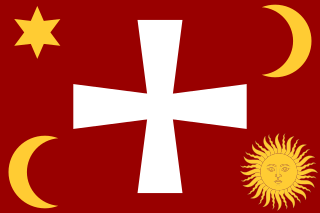
The Cossacks are a predominantly East Slavic Orthodox Christian people originating in the Pontic–Caspian steppe of eastern Ukraine and southern Russia. Historically, they were a semi-nomadic and semi-militarized people, who, while under the nominal suzerainty of various Eastern European states at the time, were allowed a great degree of self-governance in exchange for military service. Although numerous linguistic and religious groups came together to form the Cossacks, most of them coalesced and became East Slavic-speaking Orthodox Christians.

The history of the Cossacks spans several centuries.

The Zaporozhian Cossacks, Zaporozhian Cossack Army, Zaporozhian Host, or simply Zaporozhians were Cossacks who lived beyond the Dnieper Rapids. Along with Registered Cossacks and Sloboda Cossacks, Zaporozhian Cossacks played an important role in the history of Ukraine and the ethnogenesis of Ukrainians.

Kuban Cossacks, or Kubanians, are Cossacks who live in the Kuban region of Russia. Most of the Kuban Cossacks are descendants of different major groups of Cossacks who were re-settled to the western Northern Caucasus in the late 18th century. The western part of the region was settled by the Black Sea Cossack Host who were originally the Zaporozhian Cossacks of Ukraine, from 1792. The eastern and southeastern part of the host was previously administered by the Khopyour and Kuban regiments of the Caucasus Line Cossack Host and Don Cossacks, who were re-settled from the Don from 1777.

The Zaporozhian Sich was a semi-autonomous polity and proto-state of Cossacks that existed between the 16th to 18th centuries, including as an autonomous stratocratic state within the Cossack Hetmanate for over a hundred years, centred around the region now home to the Kakhovka Reservoir and spanning the lower Dnieper river in Ukraine. In different periods the area came under the sovereignty of the Polish–Lithuanian Commonwealth, the Ottoman Empire, the Tsardom of Russia, and the Russian Empire.

A Cossack host, sometimes translated as Cossack army, was an administrative subdivision of Cossacks in the Russian Empire. Earlier the term viisko referred to Cossack organizations in their historical territories, most notable being the Zaporozhian Host of Ukrainian Cossacks.

Black Sea Cossack Host, also known as Chernomoriya, was a Cossack host of the Russian Empire created in 1787 in southern Ukraine from former Zaporozhian Cossacks. In the 1790s, the host was re-settled to the Kuban River. It comprised the Caucasus Fortified Defence Line from the mouth of the Kuban River to the mouth of the Bolshaya Laba River.

Azov Cossack Host was a Cossack host that existed on the northern shore of the Sea of Azov, between 1832 and 1862.
Khortytsia is the largest island on the Dnieper river, and is 12.5 km (7.77 mi) long and up to 2.5 km (1.55 mi) wide. The island forms part of the Khortytsia National Park. This historic site is located within the city limits of Zaporizhzhia, Ukraine.

Nekrasov Cossacks, Nekrasovite Cossacks, Nekrasovites, Nekrasovtsy descend from those Don Cossacks who, after the defeat of the Bulavin Rebellion of 1707–1708, fled to the Kuban in September 1708, headed by Ignat Nekrasov, hence their name. At that time the Crimean Khanate ruled the Kuban. Later, other fugitives from the Don and runaway Russian serfs joined the Nekrasov Cossacks. The Nekrasovites were Old Believers, and hence persecuted by Orthodox Russian authorities.

The Danubian Sich was an organization of the part of former Zaporozhian Cossacks who settled in the territory of the Ottoman Empire after their previous host was disbanded and the Zaporozhian Sich was destroyed.

Antin Holovaty or Anton Golovaty ; between 1732 and 1744 – January 28, 1797 was a prominent Zaporozhian Cossack leader who after the Zaporozhian Sich's destruction was a key figure in the formation of the Black Sea Cossack Host and their later resettlement to the Kuban Region of Russia.

The Wild Fields is a historical term used in the Polish–Lithuanian documents of the 16th to 18th centuries to refer to the Pontic steppe in the territory of present-day Eastern and Southern Ukraine and Western Russia, north of the Black Sea and Azov Sea. It was the traditional name for the Black Sea steppes in the 16th and 17th centuries. In a narrow sense, it is the historical name for the demarcated and sparsely populated Black Sea steppes between the middle and lower reaches of the Dniester in the west, the lower reaches of the Don and the Siverskyi Donets in the east, from the left tributary of the Dnipro — Samara, and the upper reaches of the Southern Bug — Syniukha and Ingul in the north, to the Black and Azov Seas and Crimea in the south.

Of the different branches of Cossacks, the only one that documents allowing Jews into their society were the Cossacks of Ukraine.

Sidor Bely or Sydir Bily was Kosh ataman of the Black Sea Cossack Host.

Peter Tekeli was a Russian general-in-chief of Serb origin. He achieved the highest rank among the Serbs who served in the Imperial Russian Army.

The Danube Cossack Host was a Ukrainian Cossack Host formed in 1828, before the Russo-Turkish War (1828–1829). It was formed by descendants of the Zaporozhian Cossacks who lived in Bessarabia, especially in the Budjak region. A Ukrainian Cossack Host called the Lower Danube Budjak Host had been formed in the same area in 1807 but was disbanded shortly thereafter. The Host included volunteers from various groups, such as the Nekrasov Cossacks, Romanians, Serbs, and Bulgarians. At first, the Cossacks controlled three selos in the Akkerman Poviat: Akmangit, Starokazachye, and Volonterovka.
Alexandru Cantacuzino-Deleanu or Alexandros Kantakouzinos was a Phanariote Romanian-Greek magnate and politician.

Kost Hordiienko was a Zaporozhian Cossack Kish otaman. After 1709 he allied with Ivan Mazepa, and co-authored the Constitution of Pylyp Orlyk.

The liquidation of the Zaporozhian Sich in 1775 was the forcible destruction by Russian troops of the Cossack formation, the Nova (Pidpilnenska) Sich, and the final liquidation of the Zaporozhian Sich as a semi-autonomous Cossack polity. As a result, the Zaporozhian Lowland Host ceased to exist.









